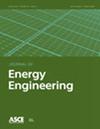改进流场设计提高质子交换膜燃料电池性能
IF 1.8
4区 工程技术
Q4 ENERGY & FUELS
引用次数: 3
摘要
燃料电池是一种将化学能转化为电能的装置。质子电解质膜燃料电池(PEMFC)对环境无污染,效率高。PEM燃料电池除产生电外,还产生水和少量的热作为副产品。在阴极一侧产生的水阻塞了流动路径并减少了电化学反应。因此,低电化学反应将影响燃料电池的性能。为了提高燃料电池的性能,可以改变燃料电池的流动参数和流场设计。利用SOLID WORKS 2008设计了一个具有25 cm2活动面积的新型流场通道的三维模型。利用ANSYS 14.5软件对实体模型进行了分析。利用ANSYS FLUENT 14.5计算了PEMFC的数值。将新型流场设计的功率密度与蛇形流场设计的功率密度进行了比较。本文章由计算机程序翻译,如有差异,请以英文原文为准。
Performance Improvement of Proton Exchange Membrane Fuel Cell by Modified Flow Field Design
Fuel cell is a device which is used to produce chemical energy into electrical energy. Proton Electrolyte Membrane fuel cell (PEMFC) was not polluting the environment and it has high efficiency. PEM fuel cell, in addition to electricity, water and small amount of heat are generated as by-products. This generated water on cathode side blocks the flow paths and reducing electrochemical reactions. So the low electrochemical reactions will affect the performance of fuel cell. To increase the performance of fuel cell, we can change the flow parameters and flow field design. A 3D model of new flow field channel has been designed with 25 cm2 active area with SOLID WORKS 2008. The solid model has been analyzed with ANSYS 14.5 software. Numerical values of PEMFC were obtained with ANSYS FLUENT 14.5. Comparison has been made for power density of new flow field design with power density of serpentine flow field design.
求助全文
通过发布文献求助,成功后即可免费获取论文全文。
去求助
来源期刊

Journal of Energy Engineering
工程技术-工程:土木
CiteScore
4.10
自引率
13.60%
发文量
61
审稿时长
3.1 months
期刊介绍:
The Journal of Energy Engineering reports on the scientific and engineering knowledge in the planning, development, management, and finances of energy-related programs. The journal is dedicated to civil engineering aspects of the issues, sources, and programs that are either directly related to, or can ultimately contribute to, the production, distribution, and storage of energy. Multidisciplinary subjects are especially encouraged.
Original contributions are encouraged in, but not limited to, the following areas: generation of electric power; nuclear power issues; energy planning (planning for generation capacity expansions, hydropower planning, network and transmission planning, reliability); energy policy and economics (financial and customer markets, regulatory and financial issues); energy development (solar power, renewable energy, waste-to-energy systems); energy systems operation (thermal and hydropower operation and optimization, scheduling, load forecasting, demand-side management); energy efficiency, reducing consumption of or conservation of energy; energy sustainability as related to energy and power production, distribution, and usage; waste management and environmental issues; and energy infrastructure issues (power plant safety, security of infrastructure network).
 求助内容:
求助内容: 应助结果提醒方式:
应助结果提醒方式:


